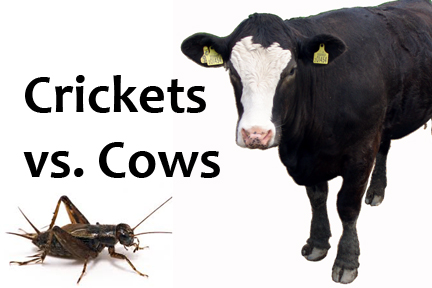Our food conversation today increasingly includes discussions of sustainable protein, and beef is often described as an environmentally unsustainable choice. This is not always a fair assessment. The US beef industry has done an amazing job of using technology to reduce the environmental impact of modern beef production operations over the past 30 years. You can learn more about sustainable beef production here.
While I am serious about learning more about sustainable food sourcing, I find it amusing that some in the food community think insects are the answer to sustainable protein sourcing.
I recently attended a conference recently where a chef stood up and proudly told the audience he was an investor and owner in a company that is raising organic, free-range crickets for cricket flour. I thought, “Holy smokes, someone is trying to punk me! He can’t be serious…organic, free-range crickets?”
The chef then virtuously described the products being made with the cricket flour, including peanut butter & jelly snack bars. Isn’t the protein from the peanut butter enough? How much protein do you need to pack into a snack bar these days to satisfy the consumers’ demand for protein? And why in the world do we need to resort to cricket flour for sustainable protein?
If you’re looking for sustainable protein, there are many sources. Your first option is to eat beef in smaller portions less often. Yes, beef has an environmental impact. So do lambs, pigs, and chickens. Their environmental impact varies on how and where they are raised as well as a host of other factors.
But don’t feel so virtuous about buying grass-fed beef. While I believe the flavor is superior, there are no significant differences in nutrient content, and because the cows take longer to reach slaughter weight, they release more methane gas, a primary contributor to green house gas emissions, which are associated with global warming.
If you’re looking for non-animal based protein, consider beans, peas, and lentils. These crops do wonders for soil health. They contain impressive amounts of protein per serving. And they come in many forms, including high protein flours. No, you can’t exchange legume flour on a one-to-one basis for wheat flour, but in many instances, they contribute wonderful flavors and textures to finished foods. And don’t limit your thinking to just the flours; consider the use of pureed pulses. You can find a wonderful recipe for Lemon Chickpea Breakfast Muffins that uses pureed chickpeas here.
Finally, don’t get so caught up in the sustainability attributes of a product or ingredient that you forget about flavor. Look for higher protein foods that contribute deliciousness, products like Greek yogurt, eggs, nuts, and nut butters.
So when it comes to crickets versus cows, which one would I root for? Well, I tried one of the peanut butter and jelly snack bars made with the organic, free-range cricket flour, and it tasted like…well, it tasted like crickets. In the battle of crickets versus cows, I’ll cheer for the cows every time. And I’ll continue to eat beef, in smaller portions less often, savoring every delicious bite!

